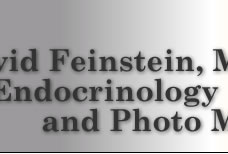


![]()
Why treat Type 2 Diabetes?
David Feinstein M.D., FRCP(C), FACP, FACE
A question that is rarely asked is “Why treat
Type 2 Diabetes?” The obvious answer is, to treat symptoms. After
all, why do patients go to see doctors? Patients want their doctors to
make their symptoms of excess thirst and urination and perhaps fatigue,
go away. It is true that treatment does relieve these symptoms, but the
majority of patients with undiagnosed or newly diagnosed Type 2 Diabetes
are asymptomatic.
Type 2 Diabetes, like hypertension, in most cases is silent. The slow
evolution of the disease allows people to adapt to the abnormal blood
sugar and people often feel worse, not better initially, after treatment
has been initiated.
The answer perhaps, to why we treat Type 2 Diabetes can be better explained
by the rationale that treatment prevents the microvascular complications
of diabetes. The microvascular complications are a collective term referring
to the areas of injury that are caused specifically by abnormally high
levels of glucose. These complications are unique to Diabetes and include
retinopathy, neuropathy and nephropathy. The reason why some tissues are
more vulnerable to injury from hyperglycemia than others, is because these
tissues can take up glucose independent of insulin. Most tissues like
muscle or adipose tissue require the presence of insulin to allow glucose
to enter the cells. Other tissues however do not require this action of
insulin and the entry of glucose into these tissues is determined by the
concentration of glucose in the blood. The higher the glucose concentration,
the more glucose is taken into these cells. These vulnerable tissues include
the lens of the eye, the myelin cells that cover nerves, parts of the
kidney, red blood cells, and the lining cells of blood vessels (endothelium).
Retinopathy involves the development of abnormal blood vessels on the
retina that can leak or bleed and if untreated can lead to blindness.
Neuropathy can involve damage to nerves, which could be part of the autonomic
or peripheral nervous system. Injury to the autonomic system could result
in dysfunction of the bowel (delayed gastric emptying), pelvic structures
(delayed bladder emptying, impotence), heart (arrhythmias). Peripheral
neuropathy can cause numbness or pain in the extremities. Loss of sensation
to the feet can lead to disturbance in muscle function which alters the
shape of the foot leading to disturbed weight bearing. This in turn predisposes
an individual to foot ulcer formation, infection and amputation. Nephropathy
refers to injury to the kidneys. The earliest abnormality is recognized
by the presence of increased amounts of protein in the urine (microalbuminuria).
Over time this can progress to impaired kidney function and still later,
kidney failure.
The mechanism by which hyperglycemia causes injury is now better understood.
Hyperglycemia causes the sugar coating of proteins (glycosylation). Once
a protein has been sugar coated, its function is altered. An example of
this is the glycosylation of hemoglobin, which can lead to a disturbance
in the ability of hemoglobin to release oxygen. This effect has only a
minor metabolic consequence, but it’s measure (glycohemoglobin or
HbA1c) has enormously helped our ability to be able to estimate the patients
overall diabetic control. This is because it’s measure reflects
the mean blood glucose that the patient has experienced over the last
ninty days (the life span of the red blood cell). Glycosylation of other
proteins are also taking place with negative consequences but their exact
effect is difficult to measure or quantify. Another mechanism by which
hyperglycemia causes injury is by the induction of specific enzymes, which,
are normally not active, when the glucose level is in the normal range.
One enzyme is Aldose Reductase which catalyzes the conversion of glucose
to sorbitol Sorbitol can accumulate in various tissues including the lens
of the eyes. Sorbitol can act as an osmotically active particle that can
cause fluids to accumulate in these involved tissues resulting in swelling
and injury. The second enzyme that has been recently recognized is Pyruvate
Kinase C. Activation of this enzyme can lead to increased release of a
number of vasoactive substances that can have a deleterious effect on
blood vessels. In the near future, attempts to block the activation of
this enzyme may help to prevent diabetic microvascular damage even in
the presence of hyperglycemia. Until then, the only option is the control
of hyperglycemia. Hypertension itself, does not cause microvascular injury,
but seems to reduce the threshold for developing these complications.
Hypertension can also cause acceleration and progression of these complications.
Control therefore, of hypertension is very important.
For years, physicians debated whether diabetic complications could be
prevented at all. It is now clear from large prospective studies such
as the DCCT Trial in Type I Diabetics and the UKPDS study in Type 2 Diabetics
that treatment is highly effective in reducing the risk of microvascular
complications. The compilation of numerous studies allows us to now say
that for every 1% decrease in the glycohemoglobin (HbA1c) there is a 35%
reduction in the risk of these complications that are unique to diabetes.
When treatment causes a drop in the glycohemoglobin from 8.5% to 6.5%,
there is a very substantial reduction in the likelihood of developing
a complication such as retinopathy. The current therapeutic imperative
is that if a patient’s glycohemoglobin is above 7%, then a change
in treatment is necessary with the goal of trying to get the glycohemoglobin
below 6.5% or perhaps as low as possible without causing excess hypoglycemia.
Although the combined morbidity caused by microvascular complications
is substantial and worthy of our attention and our concern, in general
these complications do not lead to death. The major reason we ought to
be treating patients with Type 2 Diabetes is to try to reduce, in theory,
the dramatic increase in cardiovascular disease that leads to premature
death in patients with Type 2 Diabetes.
A male with Type 2 Diabetes has a cardiovascular risk, which is double
that of a nondiabetic male.. A female with Type 2 Diabetes has a 4-fold
increase in cardiovascular risk compared to women without diabetes. The
therapeutic goal in treating Type 2 Diabetes is to do something about
reducing this dramatic risk. As of today unfortunately, it has been difficult
to demonstrate that improvement in diabetic control reliably or consistently,
reduces this risk. The UKPDS Study did demonstrate a statistically significant
reduction in vascular disease in diabetics treated with insulin or oral
hypoglycemic agents (metformin caused somewhat better results than did
treatment with sulfonylureas). A 1% decrease in glycohemoglobin was associated
with 15% decrease in cardiovascular complications (not 35% as it is with
microvascular complications). This has been explained by the fact that
the risk of vascular disease (stroke, heart attack, and peripheral vascular
disease) is multi-factorial. Hyperglycemia is only a component of the
overall metabolic derangement that leads to an acceleration of atherosclerosis.
To reduce the risk of cardiovascular disease, it is imperative to address
all the remediable cardiovascular risk factors (hyperlipidemia, hypertension,
increased coagulability) in addition to correcting the blood glucose.
The current goal for LDL cholesterol in most patients with Type 2 Diabetes
is to maintain a value less than 70 mg/dl. This is because diabetes is
considered a cardiovascular risk equivalent, which means that someone
with Type 2 Diabetes carries the same risk of developing a myocardial
infarction (heart attack) as someone else who does not have diabetes,
but has already had a heart attack. The goal of 70 ml/dl will likely require
the use of a moderate to high dose of a statin drug. Statins inhibit cholesterol
formation by blocking the rate-limiting step in cholesterol synthesis
(HMG COA reductase). In addition further reduction in cholesterol levels
can be achieved by the addition of a second drug such as Zetia that can
interfere with cholesterol absorption from the diet. An alternative is
the combination of a statin drug (Lipitor, Zocor, Crestor, Mevacor, Pravachol,
Lescol) with nicotinic acid (Niaspan), which can bring about excellent
cholesterol lowering. The use of Niaspan, has been limited because of
its common side effect of flushing. If the predominant lipid abnormality
is an elevated triglyceride and a low HDL, then a fibric acid derivative
drug ( Tricor, or Lopid), could be used. An alternative in this situation
is nicotinic acid (Niaspan). The goal for HDL is to maintain a value greater
than 40 mg/dl in males, and greater than 50mg/dl in females. Exercise
and red wine have been shown to improve HDL. In addition there will soon
be available a new drug that will specifically elevate the HDL (CETP Inhibitors).
Right now the best drug to elevate HDL is Nicotinic Acid.
The UKPDS Study clearly demonstrated the potent effect that lowering blood
pressure had on diabetic complications. The current goal is to maintain
a systolic blood pressure less than 130, and a diastolic less than 80.
Current research has shown that it is the systolic blood pressure that
carries with it the greatest risk. .For every 20 mm increase in systolic
pressure there is a doubling of cardiovascular risk. Any hypertensive
medication that lowers the blood pressure is effective, but if patients
have any degree of microalbuminuria (protein in the urine) then an ACE
inhibitor (angiotensin converting enzyme inhibitor such as Zestril, Captopril,
Altace, Aceon) orARB( angiotensin receptor blocker such as Avapro, Diovan,
Tevetin, Captopril, Benicar) is more effective. This is because they not
only reduce the blood pressure but also reduce protein excretion thus
specifically protecting the kidneys. . Treatment of hypertension in diabetics
has a greater beneficial effect in reducing cardiovascular disease than
it has in treating non-diabetics. Blood pressure control is crucial. There
is increasing evidence that ACE Inhibitors or possible ARBs may be indicated
in Type 2 Diabetics above the age of 55, even without hypertension. This
is because their use has been associated with a lower risk of cardiovascular
disease. Therefore the majority of Type 2 Diabetics will likely have an
ACE or an ARB as part of their diabetic regimen. Aspirin therapy (unless
otherwise contra-indicated) should also be used as part of a diabetic’s
prophylactic regimen because of its proven benefit in preventing strokes
and heart attacks. It is also the cheapest drug we can use that is very
effective.
The problem is that many, if not most, have well established vascular
disease by the time they are first diagnosed (though frequently are asymptomatic).
This is because diabetes is a rather late manifestation of the metabolic
syndrome. Patients have often been living with insulin resistance and
the metabolic syndrome for 10-15 years before developing diabetes and
the metabolic syndrome even without diabetes causes acceleration of atherosclerosis.
Intensive therapy with excellent glycemic control, excellent lipid and
blood pressure control and use of an ACE Inhibitor or an ARB and aspirin,
can at best only hope to slow down the rate of progression. Reversal is
still the stuff of dreams. Therefore our current treatment for type 2
diabetes, in regards to vascular disease, is often too little and too
late. If we are to hope to significantly reduce vascular disease in the
diabetic then we are going to need to identify individuals who are at
risk of developing diabetes but as of yet have not developed it (prediabetes).
Individuals who are at risk of developing diabetes are people with the
metabolic syndrome, which includes more than forty million Americans.
This condition is characterized by central obesity (abdominal circumference
>40 inches in men, or 35 inches in women) and a triglyceride >175mg/dl.
One in four people with the metabolic syndrome will go on and develop
diabetes. Women with a history of gestational diabetes, or a history of
polycystic ovarian syndrome( another insulin resistant state) are also
at great risk. Individuals with a strong family history of diabetes, or
members of an ethnic minority (Latino, American Indian, Black) are also
at significantly higher risk.
Three major studies including the Diabetes Prevention Study done in the
US have shown that a change in weight of 7% or more and modest exercise
(30 min. of walking per day) and reasonable changes in food choices (more
fiber, fruit and vegetables, and less fat) can dramatically reduce the
incidence of diabetes. In fact for many people at risk, Type 2 Diabetes
may be completely preventable. The thrust of current treatment must be,
therefore, the identification of high-risk individuals and intervening
10 years or more before they would normally have been diagnosed. It is
only then that we will have a profound effect on preventing the rising
epidemic of cardiovascular disease.
For those people who now have diabetes, I can say that treatment will do far more than just treat symptoms. Effective treatment of hyperglycemia can potentially prevent all of the microvascular complications and when combined with aggressive treatment of hypertension and hyperlipidemia can significantly reduce the progression of vascular disease. The best treatment remains prevention of diabetes or at least, a much earlier diagnosis. Promising new therapies are on the horizon, but until they do arrive, we will have to maximize the current treatments we now have available. Our patients have been failing, and we have been failing our patients. The percentages of type 2 diabetics who are achieving all three of the current goals (LDL<100, let alone<70, glycohemoglobin<6.5%, blood pressure <130/80) are probably less than 2%. These goals are in fact obtainable, if physicians and patients understand their importance and work better as a team to achieve them. The prevention of type 2 diabetes or it’s consequences are close at hand.